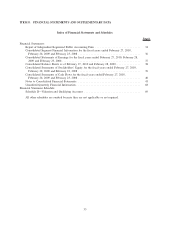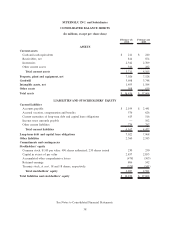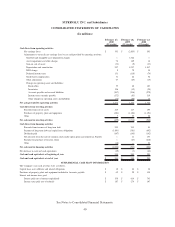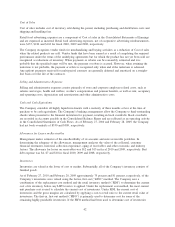Albertsons 2010 Annual Report Download - page 48
Download and view the complete annual report
Please find page 48 of the 2010 Albertsons annual report below. You can navigate through the pages in the report by either clicking on the pages listed below, or by using the keyword search tool below to find specific information within the annual report.Cost of Sales
Cost of sales includes cost of inventory sold during the period, including purchasing and distribution costs and
shipping and handling fees.
Retail food advertising expenses are a component of Cost of sales in the Consolidated Statements of Earnings
and are expensed as incurred. Retail food advertising expenses, net of cooperative advertising reimbursements,
were $137, $184 and $162 for fiscal 2010, 2009 and 2008, respectively.
The Company recognizes vendor funds for merchandising and buying activities as a reduction of Cost of sales
when the related products are sold. Vendor funds that have been earned as a result of completing the required
performance under the terms of the underlying agreements but for which the product has not yet been sold are
recognized as reductions of inventory. When payments or rebates can be reasonably estimated and it is
probable that the specified target will be met, the payment or rebate is accrued. However, when attaining the
milestone is not probable, the payment or rebate is recognized only when and if the milestone is achieved.
Any upfront payments received for multi-period contracts are generally deferred and amortized on a straight-
line basis over the life of the contracts.
Selling and Administrative Expenses
Selling and administrative expenses consist primarily of store and corporate employee-related costs, such as
salaries and wages, health and welfare, worker’s compensation and pension benefits, as well as rent, occupancy
and operating costs, depreciation and amortization and other administrative costs.
Cash and Cash Equivalents
The Company considers all highly liquid investments with a maturity of three months or less at the time of
purchase to be cash equivalents. The Company’s banking arrangements allow the Company to fund outstanding
checks when presented to the financial institution for payment, resulting in book overdrafts. Book overdrafts
are recorded in Accounts payable in the Consolidated Balance Sheets and are reflected as an operating activity
in the Consolidated Statements of Cash Flows. As of February 27, 2010 and February 28, 2009, the Company
had net book overdrafts of $330 and $389, respectively.
Allowances for Losses on Receivables
Management makes estimates of the uncollectibility of its accounts and notes receivable portfolios. In
determining the adequacy of the allowances, management analyzes the value of the collateral, customer
financial statements, historical collection experience, aging of receivables and other economic and industry
factors. The allowance for losses on receivables was $12 and $15 in fiscal 2010 and 2009, respectively. Bad
debt expense was $4, $7 and $10 in fiscal 2010, 2009 and 2008, respectively.
Inventories
Inventories are valued at the lower of cost or market. Substantially all of the Company’s inventory consists of
finished goods.
As of February 27, 2010 and February 28, 2009 approximately 79 percent and 81 percent, respectively, of the
Company’s inventories were valued using the last-in, first-out (“LIFO”) method. The Company uses a
combination of the replacement cost method and the retail inventory method (“RIM”) to determine the current
cost of its inventory before any LIFO reserve is applied. Under the replacement cost method, the most current
unit purchase cost is used to calculate the current cost of inventories. Under RIM, the current cost of
inventories and the gross margins are calculated by applying a cost-to-retail ratio to the current retail value of
inventories. The first-in, first-out method (“FIFO”) is primarily used to determine cost for some of the
remaining highly perishable inventories. If the FIFO method had been used to determine cost of inventories
42
























